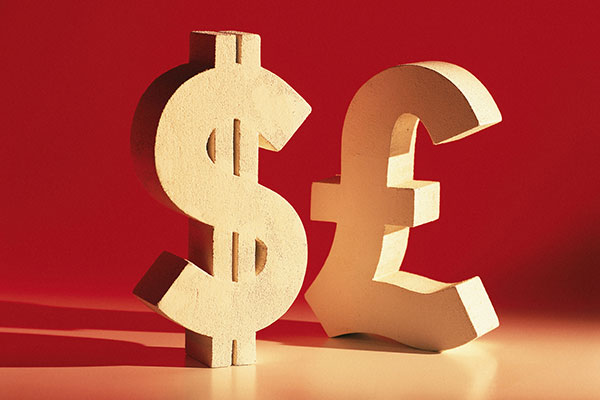How a weak pound and strong US dollar impacts fund investors
27th September 2022 09:39
by Cherry Reynard from interactive investor
Cherry Reynard asks the pros what's next for the plummeting pound and names the fund winners and losers.

Chancellor Kwasi Kwarteng’s mini-budget turned out to be seismic for currency markets, with the pound hitting all-time lows versus the US dollar. The fear is that spending promises combined with tax cuts will put an uncomfortable strain on the UK’s already stretched finances and may exacerbate the existing inflation problem. For investors in UK assets, it is an unnerving moment.
The pound has been weakening versus the dollar for much of 2022. Until recently, this had largely reflected the extraordinary strength of the US currency, which has been soaring relative to virtually all its peers. Ed Smith, co-chief investment officer at Rathbone Investment Management, says two key factors have fuelled the dollar’s ascent this year: “It nearly always does well across the board when global equities sell off and investors seek safety, as has happened recently. And there has arguably been less evidence of economic weakness in the US than in Europe or China.”
- Read about: Free regular investing | Investing in Bonds | Cashback Offers
In addition, the dollar has had “safe-haven” status, higher interest rates and the strength of the US economy on its side. It has appreciated significantly against sterling, but also against the euro, the yen and other major currencies.
The other side of the equation has been the UK’s weakness. Georgina Taylor, multi-asset fund manager at Invesco, says: “The UK has been in the eye of the storm on all fronts. Inflation is everywhere in the world, but is at a different level in the UK, which is seeing higher energy bills, a cost-of-living crisis and Brexit-related difficulties in the labour market.”
Smith points out that sterling had fallen only marginally against the euro and had actually risen against the yen. He says: “For context, sterling fell by about 19% versus the basket after the UK left the Exchange Rate Mechanism on Black Wednesday in 1992, 22% around the Brexit vote in 2016, and 30% during the Global Financial Crisis.”
- Sterling hits record low: the bond and stock market winners and losers
- Kwasi Kwarteng’s explosive mini-budget 2022: winners and losers
All change for sterling following mini-budget
However, the mini-budget has introduced a raft of new, idiosyncratic risks for the UK’s currency. Kwasi Kwateng’s tax cuts and spending package risk jeopardising the UK’s already precarious financial situation. Financial markets certainly thought so: sterling dropped precipitously against the dollar, hitting a record low yesterday of $1.035. There was also a notable rise in the 10-year gilt yield, which now stands at around 4.2%, as investors anticipated further rate rises from the Bank of England.
Perhaps more worrying was that the rise in the gilt yield didn’t support the currency. This is not how a developed market currency is supposed to behave. If a country raises its interest rates, it should be more appealing to global investors and – in turn – raise the level of the currency. In his most recent New York Times column Nobel prize-winning economist Paul Krugman said: “Right now, British markets aren’t acting like those of an advanced country. They are, instead, behaving like those of a developing country, in which investors tend to see budget deficits as a sign of irresponsibility and a harbinger of future policy disaster.”
Against this backdrop, it is difficult to see a better outcome for sterling in the near term, though it is plausible that Chancellor Kwarteng’s tactics might work over the longer term.
Moreover, as always, there’s a price for everything. However, with a giant fiscal experiment under way, it may be considerably lower than many think.

Large-caps to benefit from weak pound
Who wins if this environment of strong dollar and weak sterling persists? Taylor says: “From a market perspective, any company with overseas earnings wins in this environment. That would tend to favour the FTSE 100 over the mid- and small-caps. On the flip side, a weaker sterling will be importing higher prices for those companies that are sourcing from abroad. This may include commodities or food, for example.”
She says that the relationship on currency is not necessarily direct – some of the currency exposure will be hedged. Companies will have hedged their currency exposure on costs and, potentially on revenues as well. However, she adds, “no one will have hedged at these levels”.
Equally, it doesn’t mean it is a great time to buy companies with high dollar earnings. James Lowen, co-manager on the JOHCM UK Equity Income fund, says that with the dollar at its highest level ever versus sterling, dollar earners look expensive. He cites companies such as AstraZeneca (LSE:AZN), British American Tobacco (LSE:BATS), Unilever (LSE:ULVR) and GSK (LSE:GSK). Investors have gravitated to these stocks because they have reliable, internationally diversified revenues, but may be paying too much for that safety.
Lowen adds: “On a one to three-year view, sterling is one of the cheapest currencies in the world. Many dollar earners are on high multiples and we are avoiding them. We are only investing where dollar earners are cheap – that includes WPP (LSE:WPP), Smith (DS) (LSE:SMDS) and some of the oil and mining companies.”
- The funds, ETFs and trusts ii customers buy every month
- Where markets go next as the summer rally stalls
- The funds set to benefit from Liz Truss’ spending splurge
It is also worth noting that the strong dollar may have flattered the performance of certain global fund managers.
Anyone who has held an unhedged position in the US will have done well since the start of the year. This is because assets priced in dollars are now worth more in pounds, which has cushioned the impact of falling markets for investors who own US shares.
Equally, this may have enhanced the performance of passive over active funds. The MSCI World index is around 70% weighted to the US, higher than for most active funds that seek greater diversity.
Outlook for mid-caps and small-caps
David Taylor, co-manager on the MI Chelverton UK Equity Income fund, says that sterling has exerted a drag on small and mid-cap companies, both because they are not getting the flattering effect of rising dollar revenues and because some are seeing higher input costs. He adds: “40% of the dividends paid in the UK are paid in dollars. Even if those companies have done nothing to grow their dividends, for UK investors, those dividends have risen.” Companies that generate most of their revenue in sterling are less valuable for international buyers.
However, it is not all one-way. Taylor points out that some UK mid- and small-cap companies now look very appealing to large dollar-based private equity and corporate buyers. “A weaker pound makes these assets more attractive for foreign buyers. We’ve seen quite a few bids for companies in our fund.”
He also believes the dividend yield of smaller companies may start to look appealing relative to that of the FTSE 100, particularly if dollar strength stalls.
- Six ways the falling pound could hit your finances
- Reaction to Bank of England's big interest rate hike
While the outlook for the UK economy appears very weak and could get worse, after such significant falls the currency may not have much further to fall. Smith says: “In some circumstances, large current account deficits can indicate big currency corrections to come, particularly when they’re symptomatic of unsustainable credit bubbles. That’s often the case in countries, usually emerging economies, which finance their deficits with short-term borrowing denominated in foreign currencies. This doesn’t describe the UK, though.”
There are also significant differences with previous currency crises. In the 1970s, after the Anthony Barber tax cut and spend budget, the Bank of England was not independent. In the 1990s, sterling was pegged to the exchange rate mechanism. These issues exaggerated the problems and may not recur.
There are companies that look vulnerable and those that will benefit, but this may already be reflected in prices. There is likely to remain a lot of uncertainty around sterling – and markets hate uncertainty. Against this backdrop, the outlook seems relatively bleak for the pound, but investors should guard against believing it can only go one way and shaping their investment strategy accordingly.
These articles are provided for information purposes only. Occasionally, an opinion about whether to buy or sell a specific investment may be provided by third parties. The content is not intended to be a personal recommendation to buy or sell any financial instrument or product, or to adopt any investment strategy as it is not provided based on an assessment of your investing knowledge and experience, your financial situation or your investment objectives. The value of your investments, and the income derived from them, may go down as well as up. You may not get back all the money that you invest. The investments referred to in this article may not be suitable for all investors, and if in doubt, an investor should seek advice from a qualified investment adviser.
Full performance can be found on the company or index summary page on the interactive investor website. Simply click on the company's or index name highlighted in the article.